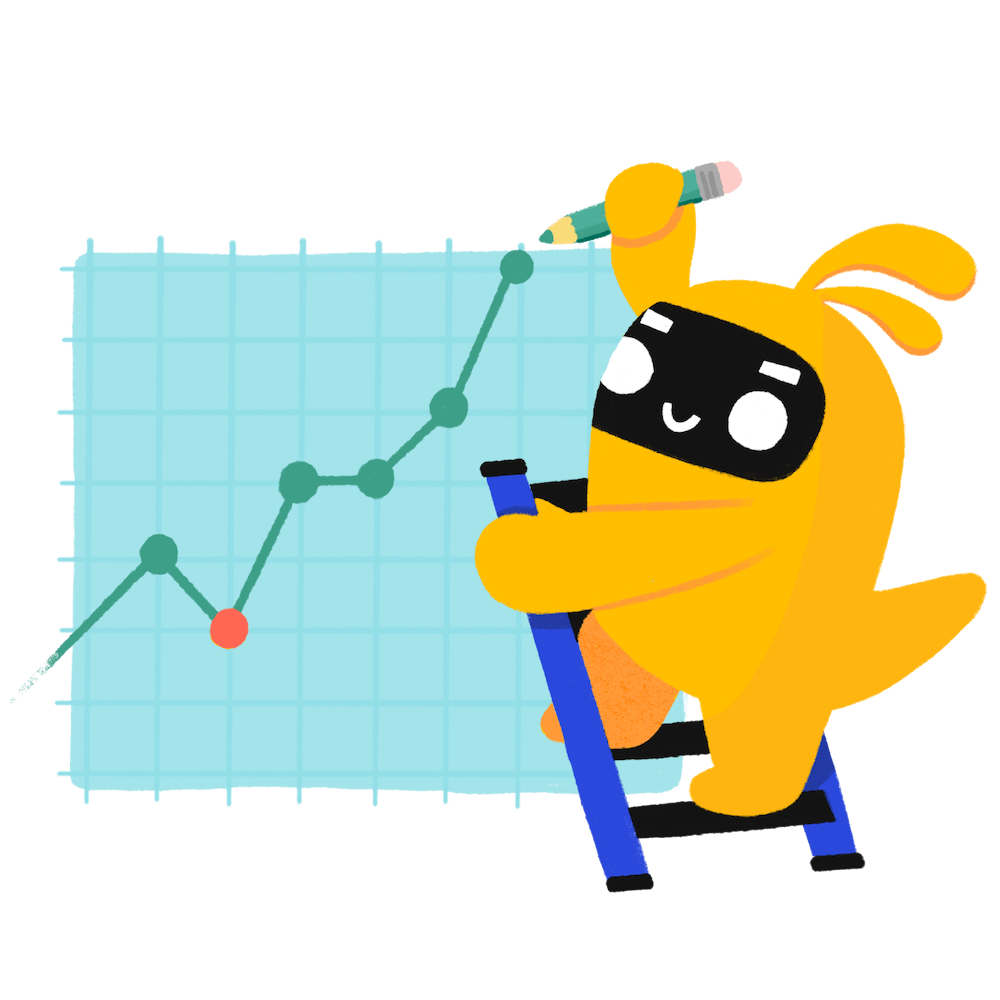6 customisable OKR examples for Product Market Fit
What are Product Market Fit OKRs?
The Objective and Key Results (OKR) framework is a simple goal-setting methodology that was introduced at Intel by Andy Grove in the 70s. It became popular after John Doerr introduced it to Google in the 90s, and it's now used by teams of all sizes to set and track ambitious goals at scale.
Creating impactful OKRs can be a daunting task, especially for newcomers. Shifting your focus from projects to outcomes is key to successful planning.
We've tailored a list of OKRs examples for Product Market Fit to help you. You can look at any of the templates below to get some inspiration for your own goals.
If you want to learn more about the framework, you can read our OKR guide online.
Building your own Product Market Fit OKRs with AI
While we have some examples available, it's likely that you'll have specific scenarios that aren't covered here. You can use our free AI generator below or our more complete goal-setting system to generate your own OKRs.
Feel free to explore our tools:
- Use our free OKR generator
- Use Tability, a complete platform to set and track OKRs and initiatives, including a GPT-4 powered goal generator
Our customisable Product Market Fit OKRs examples
You will find in the next section many different Product Market Fit Objectives and Key Results. We've included strategic initiatives in our templates to give you a better idea of the different between the key results (how we measure progress), and the initiatives (what we do to achieve the results).
Hope you'll find this helpful!
1. OKRs to achieve Product-Market Fit (PMF)
Achieve Product-Market Fit (PMF)
Acquire 50 new active users weekly to validate market demand
Improve referral program to incentivize existing users
Optimize website for user accessibility and engagement
Develop and implement a strategic social media marketing plan
Improve key product feature based on feedback to increase user retention by 20%
Develop and implement the improvement strategy
Analyze feedback for ideas to enhance the key product feature
Monitor user retention rates for improvements
Conduct 25 customer interviews to understand product usage and satisfaction
Develop a comprehensive interview questionnaire
Identify 25 customers who actively use the product
Conduct and record customer interviews
2. OKRs to achieve product-market fit and expand market reach
Achieve product-market fit and expand market reach
Increase customer satisfaction level by 30% through product improvements
Conduct surveys to identify areas of the product needing improvement
Implement improvements and track customer satisfaction levels
Develop a roadmap for product enhancements based on customer feedback
Establish partnerships in two new markets and secure initial contracts
Initiate business proposals with potential partners
Identify potential partners in target markets
Negotiate and secure initial contracts
Increase product usage by 25% in the newly penetrated markets
Offer promotional trials to entice initial usage
Implement product training sessions for new consumers
Launch targeted marketing campaigns to promote product awareness
3. OKRs to achieve product market fit under the Sean Ellis framework
Achieve product market fit under the Sean Ellis framework
Achieve 20% increase in customer retention due to added product value
Improve customer service response times
Implement customer feedback to enhance product features
Develop loyalty programs for repeat customers
Scale to secure 100 new weekly active users experiencing must-have product experience
Foster referrals through an attractive incentive program
Enhance user experience with spot-on must-have features
Implement targeted online marketing to reach potential users
Define and measure the primary product value metric by reaching 75% positive customer ratings
Identify primary value metric of the product
Develop a system to track customer ratings
Implement strategies to achieve 75% positive feedback
4. OKRs to achieve Product-Market fit
Achieve Product-Market fit
40% of new users are still active after 2 months
Identify and build core missing features
Talk to 20 leads and users
Get a 40% score on Product-Market fit survey
Send survey to existing beta users
Create a product-market fit survey on Typeform
Get 100 new leads every week
Build a sustainable growth channel
Establish referral program to turn successful users into advocates
5. OKRs to enhance product-market fit by conducting customer research and implementing user feedback
Improve product-market fit by leveraging customer research and user feedback
Measure the impact of the improvements on product-market fit by tracking user metrics
Conduct in-depth interviews with 50 potential and existing customers
Implement the top 3 product improvements within 3 weeks
Analyze user feedback and identify the top 3 product improvements
6. OKRs to attain product market fit for our offering
Attain product market fit for our offering
Conduct 150 customer interviews to gather feedback about the product
Conduct interviews and gather feedback
Identify 150 customers willing to give feedback
Prepare comprehensive interview guide
Achieve a monthly churn rate lower than 5%
Implement effective customer retention strategies
Regularly monitor and analyze churn data
Enhance customer service interactions
Increase product active usage by 20%
Launch a targeted in-app promotional campaign
Develop engaging features based on user feedback and preferences
Implement a comprehensive user onboarding program
Product Market Fit OKR best practices to boost success
Generally speaking, your objectives should be ambitious yet achievable, and your key results should be measurable and time-bound (using the SMART framework can be helpful). It is also recommended to list strategic initiatives under your key results, as it'll help you avoid the common mistake of listing projects in your KRs.
Here are a couple of best practices extracted from our OKR implementation guide 👇
Tip #1: Limit the number of key results
The #1 role of OKRs is to help you and your team focus on what really matters. Business-as-usual activities will still be happening, but you do not need to track your entire roadmap in the OKRs.
We recommend having 3-4 objectives, and 3-4 key results per objective. A platform like Tability can run audits on your data to help you identify the plans that have too many goals.
 Tability's audit dashboard will highlight opportunities to improve OKRs
Tability's audit dashboard will highlight opportunities to improve OKRsTip #2: Commit to weekly OKR check-ins
Don't fall into the set-and-forget trap. It is important to adopt a weekly check-in process to get the full value of your OKRs and make your strategy agile – otherwise this is nothing more than a reporting exercise.
Being able to see trends for your key results will also keep yourself honest.
 Tability's check-ins will save you hours and increase transparency
Tability's check-ins will save you hours and increase transparencyTip #3: No more than 2 yellow statuses in a row
Yes, this is another tip for goal-tracking instead of goal-setting (but you'll get plenty of OKR examples above). But, once you have your goals defined, it will be your ability to keep the right sense of urgency that will make the difference.
As a rule of thumb, it's best to avoid having more than 2 yellow/at risk statuses in a row.
Make a call on the 3rd update. You should be either back on track, or off track. This sounds harsh but it's the best way to signal risks early enough to fix things.
How to turn your Product Market Fit OKRs in a strategy map
The rules of OKRs are simple. Quarterly OKRs should be tracked weekly, and yearly OKRs should be tracked monthly. Reviewing progress periodically has several advantages:
- It brings the goals back to the top of the mind
- It will highlight poorly set OKRs
- It will surface execution risks
- It improves transparency and accountability
Spreadsheets are enough to get started. Then, once you need to scale you can use a proper OKR platform to make things easier.
 Tability's Strategy Map makes it easy to see all your org's OKRs
Tability's Strategy Map makes it easy to see all your org's OKRsIf you're not yet set on a tool, you can check out the 5 best OKR tracking templates guide to find the best way to monitor progress during the quarter.
More Product Market Fit OKR templates
We have more templates to help you draft your team goals and OKRs.
OKRs to master JavaScript fundamentals and apply them in real-life coding projects
OKRs to enhance efficiency through digital platform integration and automation
OKRs to enhance competitiveness in compensation and benefits program
OKRs to streamline service requests via self-service platform
OKRs to enhance user experience for increased software engagement
OKRs to establish robust strategies to prevent newsroom sellouts
OKRs resources
Here are a list of resources to help you adopt the Objectives and Key Results framework.
- To learn: What is the meaning of OKRs
- Blog posts: ODT Blog
- Success metrics: KPIs examples
Create more examples in our app
You can use Tability to create OKRs with AI – and keep yourself accountable 👀
Tability is a unique goal-tracking platform built to save hours at work and help teams stay on top of their goals.
 1 Create your workspace
1 Create your workspace 2 Build plans in seconds with AI
2 Build plans in seconds with AI 3Track your progress
3Track your progress